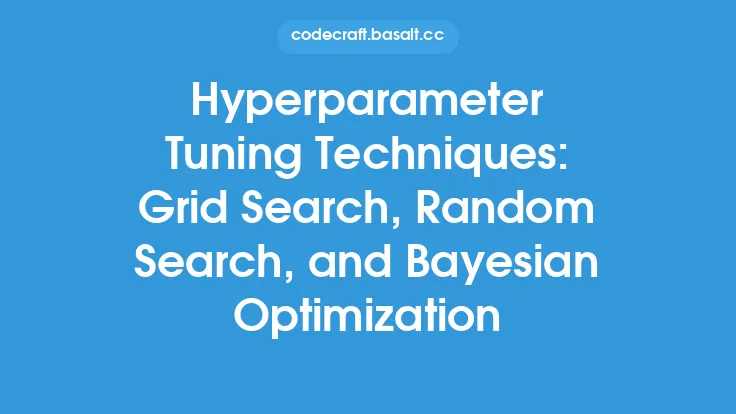Deep learning models have revolutionized the field of machine learning, achieving state-of-the-art performance in a wide range of applications, from image and speech recognition to natural language processing and game playing. However, the success of these models heavily relies on the careful selection of hyperparameters, which are parameters that are set before training the model. Hyperparameter tuning is the process of searching for the optimal combination of hyperparameters that results in the best performance of the model. In this article, we will delve into the challenges and opportunities of hyperparameter tuning for deep learning models, exploring the complexities of the process and the techniques used to overcome them.
Introduction to Hyperparameter Tuning
Hyperparameter tuning is a crucial step in the development of deep learning models. Hyperparameters are parameters that are not learned during training, but are instead set before training begins. Examples of hyperparameters include the learning rate, batch size, number of hidden layers, and number of units in each layer. The choice of hyperparameters has a significant impact on the performance of the model, and finding the optimal combination of hyperparameters can be a challenging task. Hyperparameter tuning involves searching through a high-dimensional space of possible hyperparameter combinations to find the one that results in the best performance of the model.
Challenges of Hyperparameter Tuning
Hyperparameter tuning is a challenging task due to the high dimensionality of the hyperparameter space and the computational cost of training a deep learning model. The number of possible hyperparameter combinations is exponentially large, making it impossible to exhaustively search through all of them. Furthermore, training a deep learning model can be computationally expensive, requiring significant amounts of time and resources. This makes it difficult to perform a thorough search of the hyperparameter space, and instead, researchers and practitioners often rely on heuristics and trial-and-error approaches.
Opportunities of Hyperparameter Tuning
Despite the challenges, hyperparameter tuning also presents several opportunities for improving the performance of deep learning models. One of the main opportunities is the ability to automate the hyperparameter tuning process using techniques such as Bayesian optimization and gradient-based optimization. These techniques can efficiently search through the hyperparameter space and find the optimal combination of hyperparameters, reducing the need for manual tuning and trial-and-error approaches. Another opportunity is the use of hyperparameter tuning to improve the robustness and generalizability of deep learning models. By tuning hyperparameters to optimize the performance of the model on a validation set, researchers and practitioners can improve the model's ability to generalize to new, unseen data.
Hyperparameter Tuning Techniques
Several techniques have been developed to perform hyperparameter tuning, including grid search, random search, Bayesian optimization, and gradient-based optimization. Grid search involves exhaustively searching through a predefined grid of hyperparameter combinations, while random search involves randomly sampling the hyperparameter space. Bayesian optimization uses a probabilistic approach to search for the optimal hyperparameter combination, while gradient-based optimization uses gradient descent to optimize the hyperparameters. Each of these techniques has its strengths and weaknesses, and the choice of technique depends on the specific problem and the resources available.
Hyperparameter Tuning for Deep Neural Networks
Deep neural networks are a type of deep learning model that are particularly challenging to tune. These models have a large number of hyperparameters, including the number of hidden layers, the number of units in each layer, and the learning rate. Furthermore, the performance of these models can be highly sensitive to the choice of hyperparameters, making it difficult to find the optimal combination. Several techniques have been developed to tune deep neural networks, including the use of learning rate schedulers and batch normalization. Learning rate schedulers adjust the learning rate during training to improve the convergence of the model, while batch normalization normalizes the inputs to each layer to improve the stability of the model.
Hyperparameter Tuning for Convolutional Neural Networks
Convolutional neural networks (CNNs) are a type of deep learning model that are widely used for image recognition and computer vision tasks. These models have a number of hyperparameters that need to be tuned, including the number of filters, the kernel size, and the stride. Furthermore, the performance of CNNs can be highly sensitive to the choice of hyperparameters, making it difficult to find the optimal combination. Several techniques have been developed to tune CNNs, including the use of transfer learning and data augmentation. Transfer learning involves using a pre-trained model as a starting point for the tuning process, while data augmentation involves augmenting the training data to improve the robustness of the model.
Hyperparameter Tuning for Recurrent Neural Networks
Recurrent neural networks (RNNs) are a type of deep learning model that are widely used for natural language processing and time series forecasting tasks. These models have a number of hyperparameters that need to be tuned, including the number of hidden layers, the number of units in each layer, and the learning rate. Furthermore, the performance of RNNs can be highly sensitive to the choice of hyperparameters, making it difficult to find the optimal combination. Several techniques have been developed to tune RNNs, including the use of long short-term memory (LSTM) units and gated recurrent units (GRUs). LSTM units and GRUs are types of RNN units that are designed to handle the vanishing gradient problem, which can make it difficult to train RNNs.
Conclusion
Hyperparameter tuning is a crucial step in the development of deep learning models, and it presents several challenges and opportunities. The high dimensionality of the hyperparameter space and the computational cost of training a deep learning model make it difficult to perform a thorough search of the hyperparameter space. However, techniques such as Bayesian optimization and gradient-based optimization can efficiently search through the hyperparameter space and find the optimal combination of hyperparameters. Furthermore, hyperparameter tuning can be used to improve the robustness and generalizability of deep learning models, making it a critical component of the model development process. By understanding the challenges and opportunities of hyperparameter tuning, researchers and practitioners can develop more effective deep learning models that achieve state-of-the-art performance in a wide range of applications.





